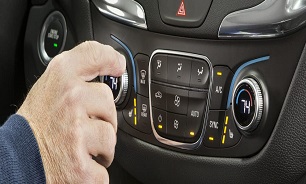How to Get the Most Out of Your Car's Heater
One surprising tip: Run the A/C. Here's why.

KhodroCar - Winter is here, so it’s time to understand how to maximize your car’s heater to keep you and your passengers comfortable and safe.
Get the Car Moving
"Modern cars don't need much to warm up before taking off, but it does take a long time for cars to warm up if they're not moving,” says Jake Fisher, director of auto testing at Consumer Reports. "The sooner you move, the sooner the engine begins working, the sooner the engine starts creating heat that will warm the passengers.”
Keep the A/C On
To most drivers, A/C means cold air. But really, that button on your dash controls the air-conditioning compressor, which performs a very important task when temperatures dip, namely dehumidifying the air. Shutting it off can cause the car's windows to fog up.
"Even if you want warm air from your system, turning the A/C on will cool the cabin air down to just above freezing before it is reheated,” Fisher says. "This removes moisture from the air, which otherwise would collect on cold glass, keeping you from being able to see out.”
When the outside temperature dips below freezing, the A/C compressor will shut itself off even if the light stays on. Leave it on and forget about it. The A/C doesn't have to work very hard when the outside air is cool, so it doesn't put much of a strain on the engine or use much extra fuel.
Crack a Window
If you are carrying several passengers, you may find it difficult to keep the windows from fogging. When passengers exhale, more water vapor is released in the cabin, and that can cling to the windows, fogging them up. Cracking a window slightly can help keep them clear.
Keep It as Warm as You Like
Some people don't want to use the A/C a lot in the summer to save fuel (and by extension, money). The good news is, in the winter, the heat is free (unless you have an electric car).
"The heat is generated by the engine, and if you don't use it, it's just going to get dumped through the radiator,” Fisher says.
"Modern cars don't need much to warm up before taking off, but it does take a long time for cars to warm up if they're not moving,” says Jake Fisher, director of auto testing at Consumer Reports. "The sooner you move, the sooner the engine begins working, the sooner the engine starts creating heat that will warm the passengers.”
Keep the A/C On
To most drivers, A/C means cold air. But really, that button on your dash controls the air-conditioning compressor, which performs a very important task when temperatures dip, namely dehumidifying the air. Shutting it off can cause the car's windows to fog up.
"Even if you want warm air from your system, turning the A/C on will cool the cabin air down to just above freezing before it is reheated,” Fisher says. "This removes moisture from the air, which otherwise would collect on cold glass, keeping you from being able to see out.”
When the outside temperature dips below freezing, the A/C compressor will shut itself off even if the light stays on. Leave it on and forget about it. The A/C doesn't have to work very hard when the outside air is cool, so it doesn't put much of a strain on the engine or use much extra fuel.
Crack a Window
If you are carrying several passengers, you may find it difficult to keep the windows from fogging. When passengers exhale, more water vapor is released in the cabin, and that can cling to the windows, fogging them up. Cracking a window slightly can help keep them clear.
Keep It as Warm as You Like
Some people don't want to use the A/C a lot in the summer to save fuel (and by extension, money). The good news is, in the winter, the heat is free (unless you have an electric car).
"The heat is generated by the engine, and if you don't use it, it's just going to get dumped through the radiator,” Fisher says.
Latest News


